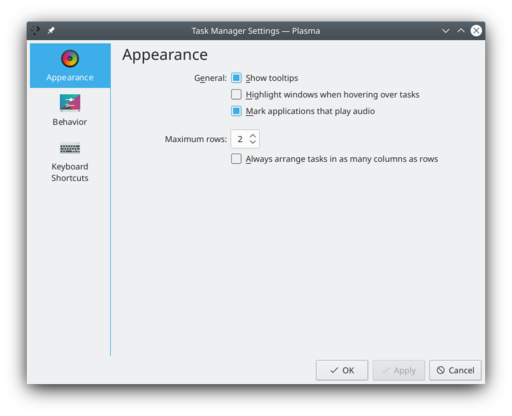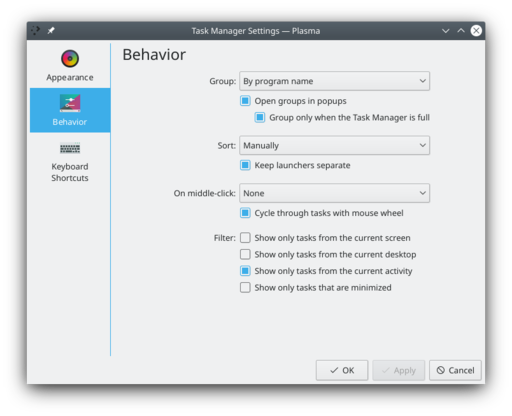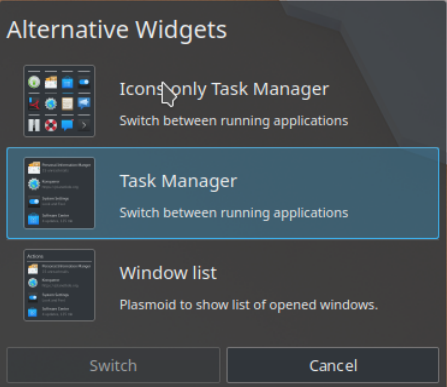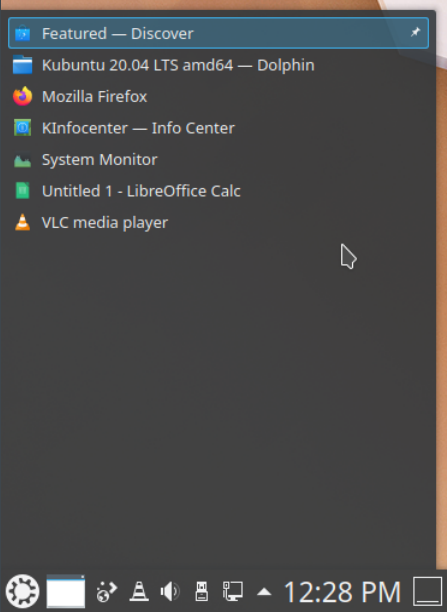Plasma/Tasks
The Plasma Task Manager

The Task Manager provides easy access to running applications. It is located in the middle section of the Panel. If the window of an application has been placed behind other windows or if it has been minimized you can bring it up and ready to receive input by clicking its tab in the Task Manager.
The Task Manager widget
The Task Manager is actually a widget, which means that you can place it anywhere. For example, you could add a new panel to (say) the top of the screen and place the Task Manager there or you could place it on the desktop if you wish. You can even have several copies of it in various places.
Whenever you start an application you will see a new tab in the Task Manager showing the icon of the application and the title of the window that was opened.
If you click on the tab corresponding to the active window then that window will be minimized. If there are still windows that have not been minimized then the frontmost of them will become active. If you click on the tab of a minimized window it will be displayed in front of all other windows, and it will become active. If you click on the tab of a window which is displayed behind other windows it will be brought in front of all other windows, and it will become active.
You can also right-click a tab to bring up the context menu. This gives you a number of options. For example, you can set which virtual screens the windows are displayed on, and you can close the window.

If you have many windows opened the tabs may be grouped. In that case you will see a number with a small arrow above in the right hand side of the tab. Clicking on such a tab will bring up a list of tabs for individual windows that you can use just like ordinary Task Manager tabs. Right-clicking a group gives you the option to close all windows in that group.
You can also activate windows by holding Alt down while pressing Tab one or more times. This way you browse through all windows whether displayed or minimized.
Configuration
To access the Task Manager settings menu, right-click on it and click . If you have troubles to click on it and not in one of its tasks, you can first click the panel toolbox, so wherever you click on the Task Manager will work.


There you can change its behavior. The following settings are particularly useful:
- Grouping and Sorting
- Grouping can be by or not at all. (You can also choose to only enable grouping if the taskbar is full.) Similarly, Sorting defaults to , but it can also be , , or .
- Filters
- There are several options for not showing all tasks in the tasks manager, but to filter only for those you want to see.
- You may
- You may
- You may
- You may
- Have More than One Row on the Taskbar
- If you use many applications at one time you may find it advantageous to set and then .
- Two useful checkboxes in the section of the page
Tooltips is a small preview thumbnail of task.
Applications that play audio are marked with a small loudspeaker symbol, which makes it easier to identify where audio played is coming from.
Alternative Task Managers

You may exchange the standard task manager widget against two other options. To do so, click with right mouse button on the task manager and choose from the context menu. One is the and the other one ist the . Let us look at both.
Icons only Task Manager

The Icons Only Task Manager shows task only by their icon and not by icon and title of the window opened. This needs less space and there can be more task shown. This task manager has by and lage the same configuration options as the standard task manager.
Windows List

With Windows List the task manager shrinks to only one icon to be displayed. Clicking on this icon opens the list of tasks. This widget has virtually no configuration options.

